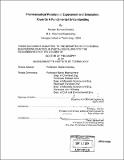| dc.contributor.advisor | Charles L. Cooney. | en_US |
| dc.contributor.author | Domike, Reuben Dumont, 1979- | en_US |
| dc.contributor.other | Massachusetts Institute of Technology. Dept. of Chemical Engineering. | en_US |
| dc.date.accessioned | 2005-09-27T17:33:41Z | |
| dc.date.available | 2005-09-27T17:33:41Z | |
| dc.date.issued | 2004 | en_US |
| dc.identifier.uri | http://hdl.handle.net/1721.1/28659 | |
| dc.description | Thesis (Ph. D.)--Massachusetts Institute of Technology, Dept. of Chemical Engineering, September 2004. | en_US |
| dc.description | Includes bibliographical references. | en_US |
| dc.description.abstract | (cont.) The DEM simulation was used to simulate the relative importance of cohesion and friction. For angle of repose simulations, increasing the cohesion increased the final angle in a consistent, linear fashion. Increasing the interparticle friction coefficient increased the final angle up to a critical friction coefficient. For the range of two dimensional simulations with the particles shaped as discs, this critical friction coefficient was about 0.30. Above this threshold, increasing the interparticle friction had no impact on the angle of repose. This suggests that for most pharmaceutical powders, the cohesion and shape are the most important particle properties. Case studies relating interparticle adhesion to labscale powder performance (flow and blends) were completed with two active pharmaceutical ingredients and a number of excipients. In all of the flow cases, the rank order of interparticle or intermaterial adhesion forces measured with AFM was exactly predictive of the rank order of ease of flow. Similarly, in all of the blending case studies, the rank order of adhesion force between the active pharmaceutical ingredient and the excipient was exactly predictive of the rank order stability of blends of the materials. The blend stability was quantified using an on-line, nondestructive, noninvasive light induced fluorescence (LIF) instrument. Separately, the LIF instrument was used to estimate the content of fluorescent drugs (caffeine and triamterene) in tablets by measuring the surface fluorescence. A theoretical description of the accuracy of the surface measurement to correctly estimate the total content in a tablet ... | en_US |
| dc.description.abstract | The flow of fine powder has not been fully understood nor has it been predictable by current simulation techniques. With the use of atomic force microscopy (AFM), interparticle forces of attraction and interparticle friction forces between fine particles have been measured with unprecedented success. In a novel coupling of technologies, the microscopic interparticle force data was used in a discrete element model (DEM) simulation to predict the bulk powder flow in multiple geometries. Excellent agreement between the simulated angles of repose for both glass beads and a microcrystalline cellulose pharmaceutical excipient was obtained. Qualitative agreement between simulation and experiment of flow in a rotating box was also obtained for these materials. The ability to measure interparticle friction forces for non-spherical particles was a novel development. The presence of surface asperities was shown to be directly responsible for changes in friction force. Interparticle friction coefficients were established by varying the applied load between particles. The average interparticle friction between the cellulose particles was 0.44, double the value for glass beads. For both particle types, the population of measured friction coefficients was well represented by a normal distribution. Interparticle friction was also measured between lactose particles. However, the surfaces of the lactose particles smoothed under high applied loads and the measured friction coefficients were lower (an average value of 0.26) than the cellulose particles. The similar friction coefficients for glass beads and smooth lactose particles further suggest that the interparticle friction was strongly dependent upon the surface asperities. | en_US |
| dc.description.statementofresponsibility | by Reuben Dumont Domike. | en_US |
| dc.format.extent | 179 p. | en_US |
| dc.format.extent | 13855775 bytes | |
| dc.format.extent | 13878083 bytes | |
| dc.format.mimetype | application/pdf | |
| dc.format.mimetype | application/pdf | |
| dc.language.iso | en_US | |
| dc.publisher | Massachusetts Institute of Technology | en_US |
| dc.rights | M.I.T. theses are protected by copyright. They may be viewed from this source for any purpose, but reproduction or distribution in any format is prohibited without written permission. See provided URL for inquiries about permission. | en_US |
| dc.rights.uri | http://dspace.mit.edu/handle/1721.1/7582 | |
| dc.subject | Chemical Engineering. | en_US |
| dc.title | Pharmaceutical powders in experiment and simulation : towards a fundamental understanding | en_US |
| dc.type | Thesis | en_US |
| dc.description.degree | Ph.D. | en_US |
| dc.contributor.department | Massachusetts Institute of Technology. Department of Chemical Engineering | |
| dc.identifier.oclc | 58968018 | en_US |
